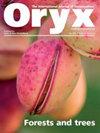Viability of ‘ōhai Sesbania tomentosa seeds after 3 decades of ambient conditions
IF 2.1
3区 环境科学与生态学
Q2 BIODIVERSITY CONSERVATION
引用次数: 0
Abstract
The plant species在30年的环境条件下,ōhai芝麻籽的生存能力
植物种Sesbania tomentosa (' ōhai;豆科植物(Fabaceae)是夏威夷群岛特有的植物,在美国联邦政府列为濒危物种,并已被提议列入世界自然保护联盟红色名录中的易危物种。2021年,在环境植物标本室条件下(相对湿度为55%,温度为20°c),从1990-1992年从夏威夷群岛各地收集的12个种子批次中发现了约12,000颗种子。国际基因库标准建议在15%相对湿度下平衡干燥种子,并在- 18°C下保存。为了研究种子的生存能力,我们在25/15°C的温度下,分别在光照12 h和黑暗12 h的交替制度下,对每个品种的15颗种子进行机械固化,然后播种。7 d后观察萌发,34 d后结束。平均最终发芽率为88.9±SD 0.1%(范围73-100%)。每一批种子都被纳入国家热带植物园的种子库和实验室。在具有不透水种皮(即物理休眠)的种子中,如毛毛葡萄,种子可以解吸但不吸收水分。因此,如果种子最初是干燥的,尽管暴露在高RH下长达32年,种子平衡RH可能仍然很低,这可能部分解释了观察到的高发芽率。这项研究对致力于保护这种濒危夏威夷物种的管理人员具有重要意义,并表明即使是次优条件也可能在未来几十年内产生高存活率的种子。
本文章由计算机程序翻译,如有差异,请以英文原文为准。
求助全文
约1分钟内获得全文
求助全文
来源期刊

Oryx
环境科学-生态学
CiteScore
5.30
自引率
7.40%
发文量
150
审稿时长
18-36 weeks
期刊介绍:
ORYX—THE INTERNATIONAL JOURNAL OF CONSERVATION, a quarterly journal from Fauna & Flora International, publishes research on biodiversity conservation, conservation policy and sustainable use, and the interactions of these matters with social, economic and political issues. The journal has a particular interest in material with the potential to improve conservation management and practice. Explore the map for details of published articles.
 求助内容:
求助内容: 应助结果提醒方式:
应助结果提醒方式:


